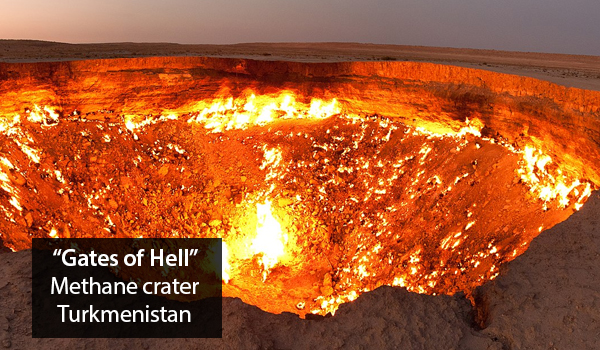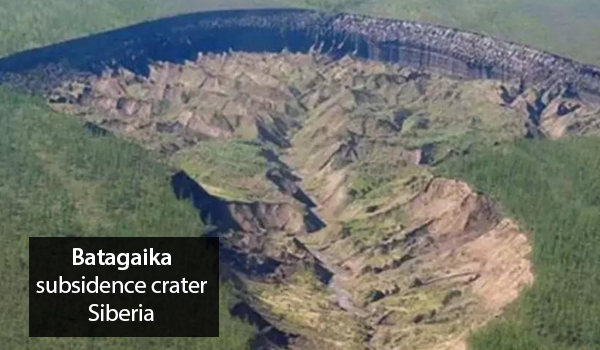

As ice melts on the lakes for the first time in thousands of years, newly released methane bubbles up from the deposits below. which can sometimes be lit. Batagaika Crater in Siberia is a half mile wide and 330 ft. deep.

New methane craters continue to blast out of the Siberian tundra.
One of the first and still the largest emerged in Turkmenistan 1971 with some help from a drilling rig and continues to burn today. The so called “Gates of Hell” (also known as the Darvaza gas crater) is about 200 ft. in diameter and 100 ft. deep. Since then, dozens of new craters have emerged without the help of humans, with blasts that can be heard 60 miles away. This anthropomorphic phenomenon is a direct result of global warming, linked to the thawing of permafrost triggered by runaway warming in the Arctic.
Methane (CH4) has been trapped beneath Arctic permafrost for many thousands of years. Now the frozen land cap is thawing across the Arctic regions, releasing massive quantities of the greenhouse gas into the atmosphere. As the permafrost thins and weakens on the surface, it is also heated from below by gas deposits.
Although it dissipates after 12 years, methane (renamed by the fossil boys “natural gas” to make it sound more friendly) is far more powerful than CO2*. It also explodes. At this point, science doesn’t know for certain how much of the gas is down there, but spewing additional megatons of CH4 into the atmosphere can’t be good.
The Clathrate Menace Beneath the Sea
And below the surface of the Arctic seas lurks another ominous peril, with a name out of a Phillip K. Dick horror fantasy. Composed of methane frozen within a crystal of water, methane clathrate (CH4·5.75H2O) or “fire ice” is found in the deepest sediments of the ocean. As the seafloor temperature increases, these reservoirs appear to be destabilizing, releasing methane into the ocean and atmosphere. While this process is not fully understood at this point, evidence is clear that there have been dramatic, rapid climatic consequences in the past. Although unproven, the “methane burp” hypothesis claims an event during the Paleocene epoch raised deep ocean temperatures about 10F.
The Megaslump that ate Siberia
In 2023, Batagaika Crater – the world’s largest permafrost crater – continued to grow in Siberia. Already more than 330 ft. deep and half a mile wide, this monster “mega-slump” is expanding at about 33 ft. a year. This part of Siberia is warming about 2.5 times faster than the rest of the planet is warming, accelerating the land surface thaw.
These non-explosive but more widespread craters are another dramatic manifestation of land subsidence caused by permafrost collapse. This phenomenon was first noted in the 1960s and is becoming more and more common as the climate warms.
Also related (and lots of fun in their own right) are thermokarst lakes: the entertainment value being related to the fact that you can light them on fire. As ice melts on the lakes for the first time in thousands of years, newly released methane bubbles up from the deposits below. The greenhouse gas emissions from these lakes deploys powerful climate effects because of the rapid release of long stored CO2.
Blowing through the albedo feedback loop
Of the many climate feedbacks at work on the planet, the “albedo” effect is one of the most convincing. As snow cover and sea ice area diminish, less solar heat energy is reflected back into space and more is absorbed into the oceans and land, further heating the planetary systems which accelerates thawing of the permafrost.
While most noticeable in Siberia, these phenomena are also taking place in Alaska and Canada.